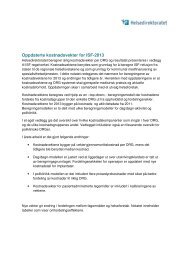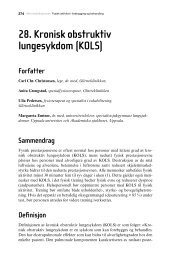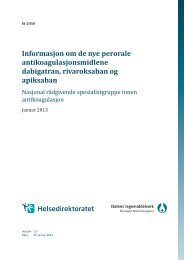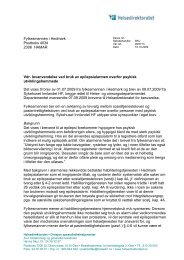Last ned - Helsedirektoratet
Last ned - Helsedirektoratet
Last ned - Helsedirektoratet
Create successful ePaper yourself
Turn your PDF publications into a flip-book with our unique Google optimized e-Paper software.
effects in a population is almost certainly increased, but this need not apply to every member<br />
of the population.<br />
-Certain. Effects have been shown through randomised and controlled intervention studies<br />
on human beings. Studies with this kind of scientific strength of evidence are only available<br />
for one time exposure due to ethical problems. It is certain that exposure on a population<br />
level increases risk, but this need not apply to every member of the population.<br />
In summary, alcohol consumption during pregnancy increases the risk of congenital<br />
malformations, abnormal facial features, retarded growth, brain damage, behavioural<br />
disturbances and cognitive problems in the child. Low alcohol intake is particularly<br />
associated with cognitive problems and behavioural disturbances. The problems are<br />
irreversible.<br />
Research now unequivocally shows that<br />
• There is no safe lower limit for alcohol intake during pregnancy<br />
• Even small amounts of alcohol can have a long-term negative influence on the<br />
behavioural and cognitive development of the child.<br />
• The problems are lifelong<br />
Damage to the child caused by alcohol is preventable. The committee therefore<br />
recommends the following:<br />
1. Pregnant women should not drink alcohol<br />
2. Pregnant women who have already consumed alcohol during pregnancy<br />
should stop drinking to minimise further risk<br />
3. Women who plan to get pregnant should not drink alcohol.<br />
Screening of alcohol habits<br />
• Screening of alcohol habits should be part of a regular routine at the first maternity<br />
medical check-up and repeated throughout the pregnancy.<br />
• There are simple screening instruments available that are practical to use and<br />
improve information about alcohol consumption considerably compared to ordinary<br />
routine questions. Pregnant women have proved to be willing to answer such<br />
questions.<br />
• Training in the use of these instruments is simple and can easily be lear<strong>ned</strong> by<br />
midwives and doctors. It is recommended that such screening instruments are part of<br />
the routine at maternity check-ups.<br />
Recommendations in case of continued alcohol consumption<br />
• Pregnant women who continue to drink after recommendations of abstinence should<br />
be offered frequent maternity check-ups to motivate for abstinence.<br />
• Women who do not quickly take advantage of this help, are referred to reinforced<br />
outpatient clinics or specialised services for pregnant women.<br />
• If policlinic support is not sufficient, one should motivate the woman to accept<br />
admission to a treatment facility for pregnant women with substance abuse problems.<br />
• For women who do not accept relevant help, and whose alcohol intake is of such a<br />
nature that it is highly probable that the child will be born with injuries, the Social<br />
Services Act on use of forced admission for treatment of pregnant women with<br />
substance abuse problems applies.<br />
13
















